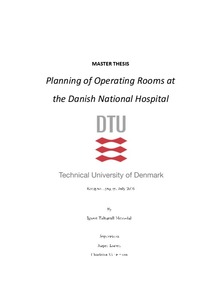Mostra el registre d'ítem simple
Planning of Operating Rooms at the Danish National Hospital
| dc.contributor | Larsen, Jasper |
| dc.contributor | Vilhelmsen, Charlotte |
| dc.contributor.author | Taltavull Mercadal, Ignasi |
| dc.coverage.spatial | east=12.56659984588623; north=55.69598249632831; name=København Ø, 2100 København, Dinamarca |
| dc.date.accessioned | 2017-07-03T15:16:39Z |
| dc.date.available | 2017-07-03T15:16:39Z |
| dc.date.issued | 2016-07 |
| dc.identifier.uri | http://hdl.handle.net/2117/106112 |
| dc.description.abstract | The irnport.ance of t.he rnanagerial aspects of hospitals can be seen in hvo mam aspects. On one hand, healt.h spending has a big irnpact on the budget. of t.he count.ries. For instance, it accounted for 11% of GDP in Demnark dnring 2014. JVloreover, it is estimated that around of 10-30% of thcse expenditures is destined to surgical facilities. Therefore, as expense centres, an cfficient pla.nning of opernting rooms is highly important to reduce costs ancl optimizc rcsources. Especially taking into account that thc demand for health services is expected to keep íncreasing in the next yea.rs beca.use of the aging populat.ion. On the othcr hand, managcment in health scrvices is also important for thc quality of the service. An efficient planning may íncrease the level of sa.tisfaction of pa.tients a.ncl medica} staff in two \vays. It can not only clecrease the amount of overtime needecl by surgeons and medica} staff but also it can reduce the \vaiting time for patients due to an optirnization of resources. In this thesis the goal \Vill be to achieve an efficíent method to assign operntions (elective pa.tíents) to opera.ting rooms where the overtíme >vork wíll be minímised, extencling the current daily planning to a multi-day planning that allows solving more than one da.y at a time (ma.ximum of v:.'eekly plan) in order to clistribute more intelligently the operations throughout the \veek. Three different approaches will be proposecl to achieve this purpose. Firstly, a detenninistic mathematical model is presented. However , although a chance of irnprovement cornpared with the daily planning is observed, t.he quality of the results in tenns of cornputational time needed is not sat.isfactory. Therefore, heuristic altcrnativcs are cxplorcd. Thc first hcuristic mcthod dcvclopcd is bascd on a priori column gcncrntion approach, and, cvcn though it givcs good result s, rcducing substantially thc running time needcd, it prcsents sorne limitations. For that rea.son, a GRASP (greedy randomized adaptivc scarch procedurc) metaheuristic approach is explorcd, where the quality of the solution obtained is thc bcst not only in tcrms of minimiza.tion of overtime vmrk for the medica} staff but a.lso in tenns of running time. From t.he results obtained frorn a dataset t.hat. includes two fnll rnont.hs tested, evidence can be extrnctcd that a multi-day planning; substantially improves the current daily planning at Rigshospitalet. |
| dc.language.iso | eng |
| dc.publisher | Universitat Politècnica de Catalunya |
| dc.publisher | Denmarks Tekniske Universitet (Technical University of Denmark) |
| dc.rights | Attribution-NonCommercial-NoDerivs 3.0 Spain |
| dc.rights.uri | http://creativecommons.org/licenses/by-nc-nd/3.0/es/ |
| dc.subject | Àrees temàtiques de la UPC::Economia i organització d'empreses |
| dc.subject.lcsh | Hospitals -- Administration -- Denmark |
| dc.title | Planning of Operating Rooms at the Danish National Hospital |
| dc.type | Master thesis |
| dc.subject.lemac | Hospitals -- Administració -- Dinamarca |
| dc.rights.access | Open Access |
| dc.audience.educationlevel | Màster |
| dc.audience.mediator | Escola Tècnica Superior d'Enginyeria Industrial de Barcelona |
| dc.description.mobility | Outgoing |


